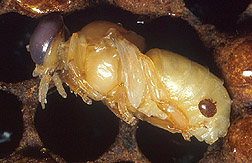This page has been archived and is being provided for reference purposes only. The page is no longer being updated, and therefore, links on the page may be invalid.
|
Read the magazine story to find out more. |
|
|
Special Line of Bees "Sniffs Out" Its Worst Enemy
By Erin PeabodyOctober 13, 2005
It turns out that a good protection against home invaders may be impeccable hygiene—at least for honey bees, according to Agricultural Research Service (ARS) entomologists who are studying bee colonies' defenses against varroa mites.
Blood-sucking, hive-wrecking varroa mites are currently the bee industry's most serious threat. These tiny but potent parasites have destroyed up to 70 percent of hives in some parts of the United States, threatening the insects that help pollinate $15 billion worth of nuts, fruits and vegetables grown annually.
In their search for a more lasting, nonchemical solution to the mounting mite problem, ARS bee researchers John Harbo and Jeffrey Harris discovered a special group of bees that rely on natural instincts to knock down a colony's mite population.
At first, the two dubbed their genetically superior bees "SMR" bees because the insects appeared to "suppress mite reproduction." The scientists suspected that the bees were transmitting chemical cues that somehow confused the ready-to-reproduce female parasites.
But with further investigation, Harbo and Harris have found that their SMR bees aren't meddling with mite reproduction after all. Instead, the bees are simply exceptional housekeepers.
The bees seem to be able to sniff out and find young, developing varroa mites. After homing in on a young mite family situated snugly inside a pocket of honeycomb, the bees initiate their fastidious cleaning. They chew away at the waxy cap of the incubator-like chamber, exposing the minute parasites' numerous vulnerabilities.
Over time, with their highly attuned, hygienic impulses, the bees are able to have a significant impact on the overall number of mites infesting a colony.
Harbo and Harris, who work at ARS' Honey Bee Breeding, Genetics and Physiology Research Unit in Baton Rouge, La., have made their unique varroa-detecting honey bees available to Glenn Apiaries, a bee supplier in Fallbrook, Calif.
Read more about the research in the October issue of Agricultural Research magazine.
ARS is the U.S. Department of Agriculture's chief in-house scientific research agency.

